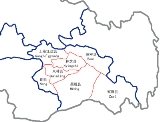
Mêdog County
Encyclopedia
Mêdog County, is a county of the Nyingtri Prefecture in the Tibet Autonomous Region
of People's Republic of China
. Chinese claims include parts of Arunachal Pradesh
, south of the McMahon Line
, what was casus belli for the 1962 Sino-Indian War.
The route for hiking to Medog: Paizhen(派镇)-Songlinkou(松林口)-Lage(拉格)-Hanmi(汗密)-Aniqiao(阿尼桥)-Beibengxiang(背崩)-Modog(墨脱)
, soybean
, cotton
and gingeli, etc. Hairy deerhorn, gastrodia tuber, muskiness, and hedgehog hydnum, etc. are special products of the area.
The Medog National Animal and Plant Reserve Area is in the county. It has more than 3,000 species of plants, 42 species of rare wild animals that under special State protection, and over a thousand of hexapod species.
ethnic group. The most renowned part of Medog is known as Pemakö, one of Tibet's most sacred power places. Inhabitants of Pemakö call themselves pemaköpa and speak Tsangla language, closely related to that of sharchokpa of eastern Bhutan.They practice Nyingma tradition of Tibetan buddhism. Frank Kingdon-Ward was the first Westerner to penetrate the deepest gorges of Pemakö, chronicled in his 1925 tome Riddle of the Tsangpo Gorges. In his 1994 "Tibet Handbook" Hongkong-born Victor Chan describes the extremely difficult trek from Pemakö Chung to the power-place and beyul
of Gonpo Ne, one of the most remote spots on earth. A modern journey by Ian Baker and his National Geographic-sponsored team to Pemakö received book-length treatment his 1994 book The Heart of the World.
Tibet Autonomous Region
The Tibet Autonomous Region , Tibet or Xizang for short, also called the Xizang Autonomous Region is a province-level autonomous region of the People's Republic of China , created in 1965....
of People's Republic of China
People's Republic of China
China , officially the People's Republic of China , is the most populous country in the world, with over 1.3 billion citizens. Located in East Asia, the country covers approximately 9.6 million square kilometres...
. Chinese claims include parts of Arunachal Pradesh
Arunachal Pradesh
Arunachal Pradesh is a state of India, located in the far northeast. It borders the states of Assam and Nagaland to the south, and shares international borders with Burma in the east, Bhutan in the west, and the People's Republic of China in the north. The majority of the territory is claimed by...
, south of the McMahon Line
McMahon Line
The McMahon Line is a line agreed to by Great Britain and Tibet as part of Simla Accord, a treaty signed in 1914. Although its legal status is disputed by China, it is the effective boundary between China and India....
, what was casus belli for the 1962 Sino-Indian War.
Geography
Medog County or Metok is located in the southeast of the Tibet Autonomous Region and at the lower branch of Yarlung Zangbo River. Medog County covers an area of 30,553 square kilometres. The average altitude of the county is 1200 metres above sea level.་Metok county is also called Pemakö.The route for hiking to Medog: Paizhen(派镇)-Songlinkou(松林口)-Lage(拉格)-Hanmi(汗密)-Aniqiao(阿尼桥)-Beibengxiang(背崩)-Modog(墨脱)
Highway
In December, 2010 the Chinese government announced completion of a highway to Mêdog County, the last county in China which did not have road access.Economy and wildlife
Farming is the main industry in Medog County. It is abundant with paddyRice
Rice is the seed of the monocot plants Oryza sativa or Oryza glaberrima . As a cereal grain, it is the most important staple food for a large part of the world's human population, especially in East Asia, Southeast Asia, South Asia, the Middle East, and the West Indies...
, soybean
Soybean
The soybean or soya bean is a species of legume native to East Asia, widely grown for its edible bean which has numerous uses...
, cotton
Cotton
Cotton is a soft, fluffy staple fiber that grows in a boll, or protective capsule, around the seeds of cotton plants of the genus Gossypium. The fiber is almost pure cellulose. The botanical purpose of cotton fiber is to aid in seed dispersal....
and gingeli, etc. Hairy deerhorn, gastrodia tuber, muskiness, and hedgehog hydnum, etc. are special products of the area.
The Medog National Animal and Plant Reserve Area is in the county. It has more than 3,000 species of plants, 42 species of rare wild animals that under special State protection, and over a thousand of hexapod species.
Demography
Medog county has a population of 9,200, and most people who live in the county are of Tshangla ethnic minority and LhobaLhoba
Lhoba is a term of obscure origin which has come to apply to a diverse amalgamation of Tibeto-Burman tribespeople living in and around "Pemako" , including Mainling, Medog, Zayü counties of Nyingchi Prefecture and Lhünzê County of Shannan Prefecture...
ethnic group. The most renowned part of Medog is known as Pemakö, one of Tibet's most sacred power places. Inhabitants of Pemakö call themselves pemaköpa and speak Tsangla language, closely related to that of sharchokpa of eastern Bhutan.They practice Nyingma tradition of Tibetan buddhism. Frank Kingdon-Ward was the first Westerner to penetrate the deepest gorges of Pemakö, chronicled in his 1925 tome Riddle of the Tsangpo Gorges. In his 1994 "Tibet Handbook" Hongkong-born Victor Chan describes the extremely difficult trek from Pemakö Chung to the power-place and beyul
Beyul
Beyul are hidden valleys, encompassing hundreds of square kilometers, which Padmasambhava blessed as refuges in the Nyingmapa Tibetan Buddhist beliefs. Terton may reveal them from terma at specific and appropriate times. Their locations were kept on scrolls hidden under rocks and inside caves,...
of Gonpo Ne, one of the most remote spots on earth. A modern journey by Ian Baker and his National Geographic-sponsored team to Pemakö received book-length treatment his 1994 book The Heart of the World.

